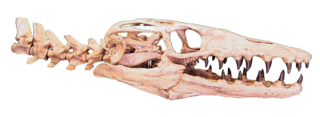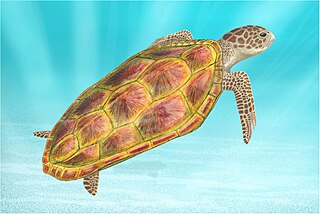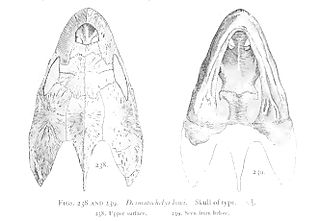
Archelon is an extinct marine turtle from the Late Cretaceous, and is the largest turtle ever to have been documented, with the biggest specimen measuring 4.6 m (15 ft) from head to tail and 2.2–3.2 t in body mass. It is known only from the Pierre Shale and has one species, A. ischyros. In the past, the genus also contained A. marshii and A. copei, though these have been reassigned to Protostega and Kansastega, respectively. The genus was named in 1895 by American paleontologist George Reber Wieland based on a skeleton from South Dakota, who placed it into the extinct family Protostegidae. The leatherback sea turtle was once thought to be its closest living relative, but now, Protostegidae is thought to be a completely separate lineage from any living sea turtle.

Selmasaurus is an extinct genus of marine lizard belonging to the mosasaur family. It is classified as part of the Plioplatecarpinae subfamily alongside genera like Angolasaurus and Platecarpus. Two species are known, S. russelli and S. johnsoni; both are exclusively known from Santonian deposits in the United States.

Lophorhothon is a genus of hadrosauroid dinosaur from the Late Cretaceous of Alabama and North Carolina. It was the first genus of dinosaur discovered in Alabama, in the United States.

Pneumatoarthrus is an extinct genus of sea turtle known from the Late Cretaceous Mount Laurel Formation of Monmouth County, New Jersey. Only a single species, P. peloreus, is known.

Protostega is an extinct genus of sea turtle containing a single species, Protostega gigas. Its fossil remains have been found in the Smoky Hill Chalk formation of western Kansas, time-equivalent beds of the Mooreville Chalk Formation of Alabama and Campanian beds of the Rybushka Formation. Fossil specimens of this species were first collected in 1871, and named by Edward Drinker Cope in 1872. With a total length of 3.9 metres (13 ft), it is the second-largest sea turtle that ever lived, second only to the giant Archelon, and one of the three largest turtle of all time along Archelon and Gigantatypus.

Protostegidae is a family of extinct marine turtles that lived during the Cretaceous period. The family includes some of the largest sea turtles that ever existed. The largest, Archelon, had a head one metre (39 in) long. Like most sea turtles, they had flattened bodies and flippers for front appendages; protostegids had minimal shells like leatherback turtles of modern times.

Santanachelys gaffneyi is an extinct species of sea turtle. It is the only species in the genus Santanachelys, which itself is a member of the extinct family Protostegidae. The species was first described from a 20-centimeter long fossil specimen unearthed in 1998 from the Santana Formation of eastern Brazil. From the rock layer from which it was excavated, it was determined that the specimen was from the Early Cretaceous period. It is therefore one of the oldest known sea turtles. but a new fossil named Desmatochelyspadillai in 2015 is estimated to be as old as 120 million years.
Corsochelys is an extinct genus of sea turtle that lived in the Late Cretaceous (Campanian). Zangerl (1960) named the type species, based upon remains found in Alabama within the Mooreville Chalk Formation.

Ctenochelys is an extinct genus of marine turtle, which existed during the Cretaceous period, and lived in the shallow waters of the Western Interior Seaway. Its fossils have been found in the Ripley Formation and Mooreville Chalk of central Alabama, United States. It was first named by C.H. Sternberg in 1904, and contains two species, C. stenoporus and C. acris.

Toxochelys is an extinct genus of marine turtle from the Late Cretaceous period. It is the most commonly found fossilized turtle species in the Smoky Hill Chalk, in western Kansas.

Notochelone is an extinct genus of sea turtle, which existed about 100 million years ago. The species was first described by Richard Owen in 1882 as Notochelys costata. It was renamed by Richard Lydekker in 1889. It was the most common marine reptile living in the inlands of the sea around Queensland, Australia. It was small turtle with carapace less than 1 metre (3.3 ft). Analytical studies have indicated that the creatures frequently ate benthic molluscs.

Desmatochelys is an extinct genus of sea turtles belonging to the family Protostegidae. This genus contains two known species, D. lowii and D. padillai. D. lowii was first discovered in 1895, followed by D. padillai in 2015. Having been estimated at over 120 million years old, D. padillai is currently the oldest known species of sea turtle.

Chelosphargis is an extinct genus of sea turtle from Upper Cretaceous of Alabama. Only one species has been described, Chelosphargis advena.

Cratochelone is an extinct genus of sea turtle in the family Protostegidae and containing a single species Cratochelone berneyi. The species is known only from the mid to late Albian Toolebuc Formation, part of the Rolling Downs Group, in the Hughenden of Central northern Queensland, Australia.
The Mooreville Chalk is a geological formation in North America, within the U.S. states of Alabama and Mississippi, which were part of the subcontinent of Appalachia. The strata date back to the early Santonian to the early Campanian stage of the Late Cretaceous. The chalk was formed by pelagic sediments deposited along the eastern edge of the Mississippi embayment. It is a unit of the Selma Group and consists of the upper Arcola Limestone Member and an unnamed lower member. Dinosaur, mosasaur, and primitive bird remains are among the fossils that have been recovered from the Mooreville Chalk Formation.

Gigantatypus is an extinct late Maastrichtian sea turtle that lived in the southern regions of the Tethys Ocean about 100–120 kilometres (62–75 mi) off the north eastern margins of Cretaceous Africa immediately before the Cretaceous–Paleogene extinction events . Fossil remains of Gigantatypus are so far only represented in sediments from Jordan. Estimated at over 3.5 metres (11 ft) in length, members of this genus reached remarkably large proportions equivalent to that of or possibly even exceeding Archelon Wieland, 1896, considered as the largest marine turtles to ever roam the oceans of the world. Although Gigantatypus apparently did not survive the K/T boundary, which also was the fate of other gigantic marine turtles such as protostegids, other genera of Cheloniidae, though significantly smaller in size survived the mass extinction and continued on until the present day.

Leyvachelys is an extinct genus of turtles in the family Sandownidae from the Early Cretaceous of the present-day Altiplano Cundiboyacense, Eastern Ranges, Colombian Andes. The genus is known only from its type species, Leyvachelys cipadi, described in 2015 by Colombian paleontologist Edwin Cadena. Fossils of Leyvachelys have been found in the fossiliferous Paja Formation, close to Villa de Leyva, Boyacá, after which the genus is named. The holotype specimen is the oldest and most complete sandownid turtle found to date.

Kansastega is an extinct genus of protostegid sea turtles that lived during the Late Cretaceous. It contains one valid species, K. copei, which has been found in the Niobrara Formation of Kansas. It was originally named as a species of Protostega, then was moved to its own genus Microstega. However, that genus name was preoccupied by the moth Microstega. As a result, Kansastega was proposed as a replacement name.
Prionochelys is an extinct genus of pancheloniid from the from the Mooreville Chalk and Eutaw Formations of Alabama. It consists of a single species, P. matutina.















